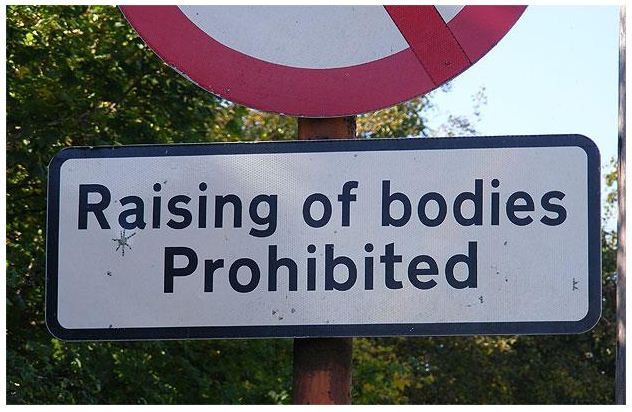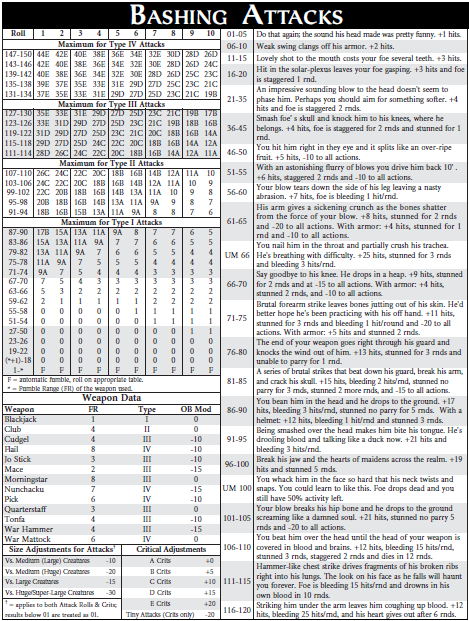So this time I am going to show you how you actually do ‘solo roleplay’. I am going to use the Mythic GM Emulator although it is not my favourite. There is an online version here.
So here is an opening scene for you. Take you favourite character, in your favourite setting and right now they are in a copse of trees over looking a ruined and abandoned manor house. It is dark, the moon has risen but is hidden by a thick layer of cloud. An owl hoots near by. Somewhere in that house is rumoured to be the blood stone. An artefact in the form of a worn and rounded granite rock the size of your fist that bears the thumbprint of one of the gods. If the legends are true placing the blood stone on the chest of a deceased person will return them to life for seven days.
So that is our plot, opening scene and character. One a piece of note paper jot down any NPCs from the characters past that may have a bearing, past villains that are still around, other adventurers they know if in the region or anyone else that could possibly crop up. Also make a short list of any ongoing story arcs that could come up again. These are the start of your thread list. The top of that list should of course be trying to find this blood stone.
So if you were playing this in a conventional game you would probably ask about lay of the land, maybe available cover, approaches and so on. There is no need to ask any of those, just make it up. It is a ruined manor so chances are it does have a drive way or road in some disrepair leading up to it. It probably has out buildings. Your setting will give you most of these answers. If this is Pern then there could be a ruins of the dragon culture. If nobility travel by carriage then there is probably going to be stables and a carriage shed. You decide. The first question we are really interested in is what can you see and what can you hear. Asking the question “Can I see any light down there?” is the perfect Yes/No format question for this style of play. First of all you make your perception roll. Use all the regular Rolemaster modifiers. Looking for lights on such a dark night is pretty easy as they stand out. If you fail the skill check then it is irrelevant if there is light to be seen or not as you didn’t see it. If you made the check then if there was a light then you saw it. So we need to know the answer. Turning to the mythic engine we need to decide how likely the answer is to be yes. I think the answer is unlikely. The stone is not being held by something as simple as a local bandit or such. If it was that simple it would have been recovered centuries ago. Of course your answer could be different, it is down to the sort of game you want and the world you are in. So my question looks like this in the GME (GM Emulator).
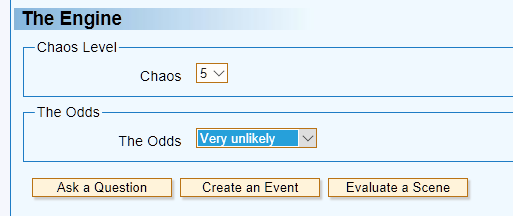 You can ignore Chaos for now. Click the Ask a Question button and you will get an answer.
You can ignore Chaos for now. Click the Ask a Question button and you will get an answer.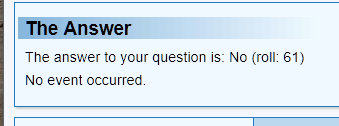 So in this case even if you made your perception roll there was no light to be seen.
So in this case even if you made your perception roll there was no light to be seen.
Our adventure continues with the here doing any other investigations he or she thinks of and slowly approaching the house. Maybe you have been making stalking rolls to approach quietly, maybe you rode up the drive on your mount. That is entirely up to you. My character has circled to the rear of the ruins quietly and is looking in through a gaping window opening trying to see if there are any signs of recent habitation. This time the perception roll was made and I got this answer.

An extreme no means not only no there is no sign of recent habitation but as definite as you can be that there was no recent habitation. I would say that even the floor in this room has collapsed down into the cellar below, the ceilings have gone and the beams that held it up lying scattered across the yawning hole in the floor.
My character out of interest in this example is Silas a 5th level Illusionist.
Maybe you want to check in more of the ground floor rooms first? So we sneak around a bit, making a few more skill checks, perception rolls and so on. Eventually you make your want into the ruins and a successful perception check about hearing any movement in the house forces the question and gets this response.
 So the answer is no, you cannot here any movement but we have an event. The focus ‘move away from a thread’ means things just got more difficult for the character. If this adventure is the only one on your threads list then the result applies to this adventure. If there are several threads on the list then roll randomly to see which thread it applies to. The meaning is often cryptic. I am going to assume that this is the only plot on the thread list so this applies to this thread. Things are about to get more difficult. Recruit wounds could mean that Silas is about to get hurt. My first thought is that the floor may give way, it is an old house and we have already seen one collapsed floor. As the floorboards crumble and disintegrate under his feet Silas attempts and fails and acrobatics roll and ends up on his back in the cellar looking up at the clouds as leaves, broken bits of rotting wood and dust rain down on him. I roll the normal falling damage and luckily he takes just a couple of hits and no critical.
So the answer is no, you cannot here any movement but we have an event. The focus ‘move away from a thread’ means things just got more difficult for the character. If this adventure is the only one on your threads list then the result applies to this adventure. If there are several threads on the list then roll randomly to see which thread it applies to. The meaning is often cryptic. I am going to assume that this is the only plot on the thread list so this applies to this thread. Things are about to get more difficult. Recruit wounds could mean that Silas is about to get hurt. My first thought is that the floor may give way, it is an old house and we have already seen one collapsed floor. As the floorboards crumble and disintegrate under his feet Silas attempts and fails and acrobatics roll and ends up on his back in the cellar looking up at the clouds as leaves, broken bits of rotting wood and dust rain down on him. I roll the normal falling damage and luckily he takes just a couple of hits and no critical.
I am going to end the first scene there and start a new scene. The reason is that the first approach and investigation was all about stealth and caution. After the fall, stealth has somewhat gone out of the window. Think of it in cinematic terms. We would certainly had the director shout “Cut!” immediately after the fall and the next shot would be down in the cellar. I like to start and end my scenes when the director would shout “Action!” and “Cut!”.
At the end of each scene ask your self is the character in control of the situation? If the answer is yes then reduce the Chaos by 1. If the answer is no then increase it by 1. Silas is not in control so from the starting point of 5 the Chaos is now 6 for future questions. We can also use the GME to evaluate this new scene.
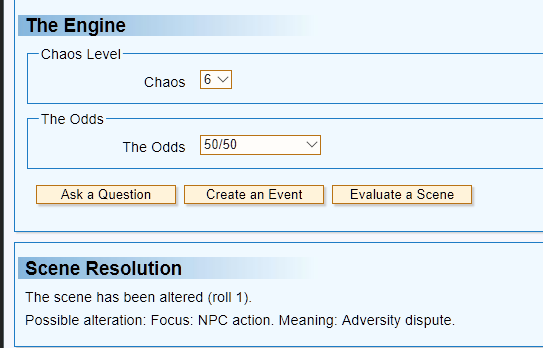
You can see the new Chaos level of 6. The Scene resolution says that the scene has be altered. This means that what you may have been expecting is not what actually happened. I was expecting a store room or wine cellar but that is not what we now have. The GME also says NPC action. Someone else has caused this altered scene and finally we Adversity dispute. The first thing that comes into my head here is that someone caused that floor to give way and it plies that someone else is also trying to get this stone. From Silas’s prone vantage point, looking up he can actually see that the joists of the floor above have been sawn through. Some one did this on purpose. Looking around he can see that the cellar has been cleared somewhat and there are signs that this has been used as a resting place. There is a bed roll over their and some cooking pots in the corner. We also add the unknown NPC to the NPC list.
Starting at the bottom of the manor house and working up is just as good as starting at the top and working down. There is a doorway out of here into a second cellar chamber. It is extremely dark so that question comes up again about can we see any light, torches, lanterns, that sort of thing. A successful perception roll is made and the GME is asked the question. This time the answer came up as a Yes. Logically if there was an NPC or monster in the next room then they would have already reacted to Silas coming though the ceiling so the light has to be reflected light from somewhere. I decide that in that next chamber are is the surface evidence of an excavation. Someone is digging some sort of tunnel or shaft. There is light playing on the ceiling from a torch or lantern down below the ground.
I am going to stop here. I hope you can see how you can build the story up. If you go with your first instinct when you see these cryptic hints from the GM Emulator and what they could mean. The setting and surroundings are what you would expect from the scene you are setting. The results of the Emulator, the altered or interrupted scenes can force you to add twists to the story. If Silas were to hear the NPC talking to themselves down the shaft that could beg the questions are they male? Are they human? Can I understand the language? A yes or no there will relate back tot he character and the languages they know. It could add a political twist to this adventure. If Silas were to cast Long Ear I (Essence’s Perceptions 5th level) what can he learn about the NPC from their mutterings?
Solo roleplay like this can be great for creating adventures, you play it solo, let the GME take you through all sorts of twists and turns. Keep notes and then put your players through it. It is great for creating interesting back stories for your PCs. How they earned that first 10,000 exp.
Imagine your GM wants to run a political campaign set in an Arabian setting. You will be starting at 3rd level. You want to play a mystic. Do some solo plays at first, second and third level in this setting with typical Arabian nights type plots and see what spells/lists you actually want or end up using.
There is of course one more use for solo play. My wife likes to watch shows like Strictly, The Voice and this new Let it Shine which I cannot bear. With solo play and an online GM emulator I can pick up a solo adventure as and when I want to. Over time you pick up a rich list of NPCs and interweaving threads. You can play game systems that your normal group cannot all agree on and otherwise sit idle on your shelf. I bought myself HARP at Christmas 2015 and it is never been played as our group are die hard RM players but with Solo play I have been on several adventures and got to know the rules.
Solo play cannot replace proper face to face play amongst friends but then PBP doesn’t replace that either. Solo play is just another aspect of our hobby that can be used by any player or GM. It is hard at first to know what you can just decide and what you should ask the GME. You don’t want to turn the game into 20 questions and you don’t want to ask world breaking questions either. ‘Does my God strike down the infidels?’ is a perfectly valid question but it is highly unlikely and the chances of an exceptional NO answer are quite high. What is the worst possible thing that can happen if you are hoping for a divine intervention to save you? There is a fair chance it involves a gate and a couple of Pale Vs.
If you have any questions about Solo play then ask below in the comments.


